Let’s now examine some images found in the Villa dei Misteri in Pompeii, which was used for the initiations of womento Dionysus’ Mysteries. These images will help us study further what we have talked about so far.

Let’s start by remembering that in Dionysian sacrifices a part of the sacrificed animal was kept after the dismemberment; it was supposed to be necessary for its future reintegration and rebirth.
Some people, in agreement with the myth of the resurrection of Dionysus Zagreus, say that this part was the heart, others the phallus [12]. It is possible that the two organs embodied the same principle in different ways. For the Greeks the heart was indeed the first organ to form in the human body, seat of the ‘vital fire’ and intelligence, whilst the phallus was the sensitive sign of the powers of fertility, dominated by both Uranian and subterranean energies, from the celestial fire of Eros as well as from the force of desire coming from the kingdom of Hephaestus, sited under the volcanoes.
In actual fact there was also a play on words between the mystic object carried in procession during Dionysian feasts, encased into a wheat sieve [13], and the words kradìa, ‘heart’ and krade, ‘fig tree’. For this reason the fig tree and its fruits were consecrated to the god and during the same processions, phalluses made of fig wood and wreathed with flowers were carried [14].
During the Dionysian mysteries the initiates took part in a night ceremony [15] (known from Demosthenes’ invective against Aeschines) during which they had to wear fawn’s skin and set up a crater of wine from which they would draw.
They were then soiled with a mixture of clay and straw, whilst the priestess emerged from the darkness, wearing a Gorgon’s mask; among the shouts of the people attending, the words: ‘I escaped evil, I found the better’ were uttered.
It is also known that women’s initiations culminated with the contemplation of the content of a covered liknon that contained a phallus [16].
Kerenyi tells us that the object contained in the liknon was treated by women like a child waking up; perhaps the Dionysus’ year started with a rite that aimed at re-awakening the phallus in the liknon.
The day after the above mentioned night ceremony, the group of initiates walked the streets carrying the kiste and the liknon, which contained the phallus covered by cakes and fruit. Some people brandished live snakes and people were crowned by fennel and white poplar.
In another feast dedicated to Dionysus, the phallophorias, big phalluses were carried and exposed to the public. According to Herodotus these feasts originated in Egypt. In the Egyptian processions mentioned by Herodotus, women carried statues with huge phalluses which, thanks to special devices, could move.
References to the phallus pervade the whole Dionysian sphere.
Stone phalluses often appeared on graves as symbols of the primary and underground generating forces of the ghenos and the descent, forces that the initiate was supposed to recognize and face inside himself in order to access the Underworld [17].
The generating power, the force of instinct and desire represented by the wooden phalluses carried in procession, is the archetype of the virility shared by men.
This gift of Dionysus is also manifested through the solar and celestial current of life that every year animates at the winter solstice, when days start getting longer and determine the reawakening of Nature. This spring current brings the lymph up the trunks and branches of trees [18] and lights the spark of Eros [19], at first in an occult and underground manner, subsequently in a more apparent way.
|

Fig. 2 – Dancing Satyr and Maenad
|
This impersonal, universal and immortal current, called Zoì by the Greeks [20], is opposed by individual existences, limited and aimed at self-preservation and self-reproduction, animated by a vital force destined to extinguish in its uniqueness, which the Greeks knew as Bios. Therefore the Zoì represented the divine and immortal nature of man, whilst ‘Bios’ was the whole of its particular manifestations, destined to Hades’ abodes sooner or later.
In the initiations and Dionysian feasts that celebrated the reawakening of the vital and instinctual principle, the role of women was fundamental. Indeed, it was the job of the feminine pole of existence to reawaken the Zoì asleep in the winter hibernation, to reawaken the sleeping fire, restart the motion of the powerful forces of desire and vital growth, paralyzed by chill and death. The wild orgiastic dances of the Maenads [21], preys to drunkenness, which half naked climbed secret mountains in order to celebrate the sacrifice and the meal of flesh, brandishing live snakes, can be associated to some of the paintings found in the Villa dei Misteri in Pompeii [22].
The frescos represent the various stages of the initiation of a newlywed matron, to the mysteries of Dionysus.
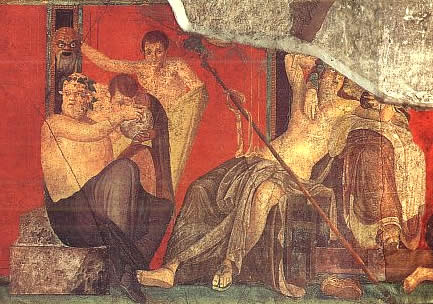
Fig. 3 – Scene of initiation – Dionysus and Ariadne
At the center of the frontal wall Ariadne embraces a half-naked and ivy-crowned Dionysus, softly lying on her lap [23].
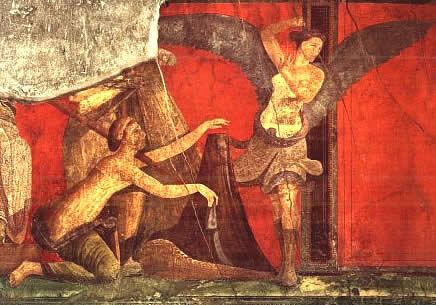
Fig. 4 – Woman that lifts the phallus in the Liknon and Nemesis that whips the Winter
|
|
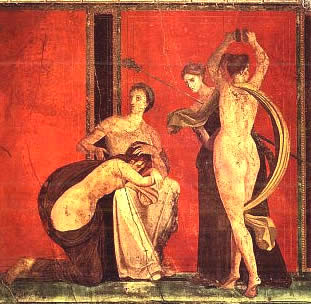
Fig 5 – The four seasons
|
Next to these two figures a woman is kneeling with an arm stretched towards a liknon and, without touching it, as if by magic, she lifts the phallos contained in the liknon, which is covered by a cloth. With the other arm she holds a torch [24]. Next to the kneeling woman another female figure is depicted in the action of striking a whiplash.
The receiver of the blow is a sad looking prone woman, who seems to be expecting the whiplash and lays her head on the knees of another sitting woman. Next to them there is a naked Maenad, only covered by a mantle’s edge that takes the shape of a crescent and another clothed Maenad that brandishes the thyrsus [25] and dances, too, heading towards the sitting woman.
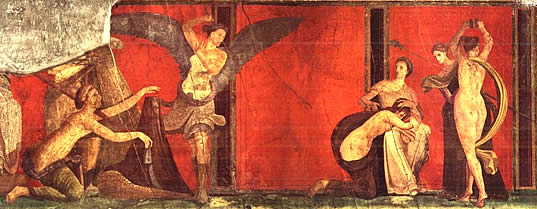
Fig. 6 – An overall view of the figures 4 and 5
The four female figures are placed so that they form a circle. The room is dominated by the image of a matron who, comfortably sitting on a high-backed chair contemplates the whole sequence of the initiation. (The image is not reproduced in this article).
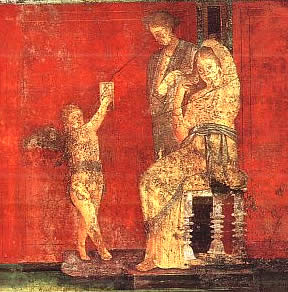
Fig. 7 – Maiden that looks at herself in the mirror and maiden that watches the initiation
On the entrance’s side two women are depicted; one of them is sitting; she is a young woman that contemplates the scene of the initiation. The other is standing and looks in a small mirror held by a winged Eros.
The figures must be considered as a whole. The kneeling woman in fig. 4, bearer of light (the torch), represents the female power, the ability to evoke the generating forces of Nature [26] and reawaken and excite male instincts and sexuality. Nemesis [27], the winged figure that brandishes the whip, is the celestial equivalent of the woman who lifts the phallus from the liknon; the whiplash of the Goddess [28] addressed at the keeling woman, who represents Winter (see fig. 6) has the effect of turning the sun cycle to the winter solstice. Days start getting longer after the hiding of light.
Nemesis, the winged angel of suffering and mourning, is therefore the other face of fertility, she who has the power of turning the sun cycle, allowing the rebirth of Dionysus dismembered by the Titans [29].
The four women in a circle are obviously the four seasons in which the year is divided. The prone woman that receives the ‘solstice’ whiplash is Winter, the naked dancing Maenad bearing the crescent is Spring; the clothed Maenad is Summer and the sitting woman looking towards Nemesis and comforting Winter is Autumn.
Nemesis’ twin sister was Aidos, Modesty, she who keeps the secrets of night, goddess possibly connected to the summer solstice and to the hiding of Sun and the beauties of Nature in the underground.
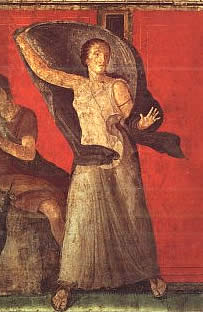
Fig. 8 – Aidos, Modesty
The two young women next to the entrance show us two complementary aspects of the rite; one of them witnesses the various scenes of initiation, whilst the other looks at herself in the mirror. This means that she recognizes inside herself the various figures of the ritual, showing that the mysteries must be used to know oneself. Therefore the two women are doing the same thing.
Now, if we look at the opposite wall, another series of frescos allow us to penetrate the hidden meaning of Dionysus’ mysteries even further.
Next to the Goddess Aidos [30], Modesty, with her face veiled, a Satyr plays the lyre and on the background we can see two Paniscas, one of which has a black goat skin, whilst the other breastfeeds a little goat. A third goat can be seen in the foreground.
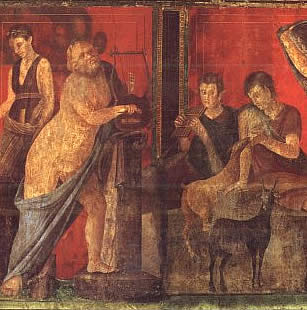
Fig. 9 – Panisca breastfeeding a goat, panisca playing the pipe and satyr playing the lyre
In the scene described above the Satyr plays the Apollinean lyre, which allows the soul to go from the world of Self and of the ‘here and now’ to the obscure world of the depth of the psyche. In the background there is the world which we accessed, revealed by the sacred music. The first panisca, breastfeeding the goat, embodies the sacred source of animal energies, vitality, Bios and primary drives.
The second panisca, playing the seven pipes syrinx, composes the melody that makes the subtle essence of any living being [31].
Life is seen as a dance that follows the sound of this invisible instrument. The panisca that holds it has the power of determining, at any time, the death of the bios that has been entrusted to her, simply by stopping playing.
Through inebriation and Dionysian possession, initiation was supposed to reveal to everybody this sacred side of the ‘animal aspect’ of human beings.
Satyrs, Eroses, paniscas, nymphs and other figures of the Dionysian procession are nothing but objectivations of the prime and inaccessible sources of human instincts, divine and sacred sources from which the initiate, descended into himself, was supposed to be able to draw in order to regenerate and transform himself.
To the left of Aidos, next to Dionysus and Ariadne, the most famous fresco from the Villa of the Mysteries; a sitting Satyr shows a hollow container to a young man that can see his image reflected into the shining interior of the cup (see fig. 3), but another young man behind the first one lifts a satyr mask oriented such that the first young man sees the mask instead of himself in the cup.
It seems that the inexpressibility, the incommensurability and frightening numinosity of divine and sacred is hidden behind what seems to come from conscious will. Each man brings in himself the hellish world of demons and dead as well as the celestial world of gods. This is the reason why the young initiate, instead of seeing his own face reflected in the cup, sees the face of an old bearded satyr, a mask that comes from the deepest abyss of his unconscious.
In this way he becomes aware fo the true origins of what he believed to be his Self, the timeless being he is inhabited by and he is initiated to the world of adult men, who know that in the monotonous passing of profane time are hidden a thousand invisible thresholds that can lead to the eternal time of gods. In other words, he becomes a man in the truest and subtlest sense of the word [32].
The fact that the young man sees his own reflection in a hollow cup destined to contain wine is connected to this symbology. The superimposition between Bacchus-Dionysus and the god of wine originates from the method of preparation of this drink, from the archaic dance of the wine-pressers masked as Satyrs and Silenus, gods of the instincts that transmute the vital energy contained in the blood, to the processes of fermentation and maturation of the wine that ‘feels’ the spring and bubbles in the vats, perfecting thanks to the celestial fire that animates it [33].
The wine, blood of the Earth, leads to procreation, possession, brotherhood and conviviality, sensuality and loss of inhibitions.
In other words, drinking wine helped the onset of mania in the people possessed by Dionysus and arose an aspect of instinct otherwise blocked by many conditionings, because it was considered dangerous. This experience led the initiate to the stupor typical of people who realize that they are inhabited by invisible and unknown forces. ‘Once his individuality is broken’,says Colli in The Greek Wisdom, "the person possessed by Dionysus sees what non initiates can’t".
Into this hidden affinity between the subterranean regions of the psyche and the celestial regions is the whole sense of women’s initiations and the role of Dionysus as ‘Soter’, viz. ‘savior’ and women’s god.
The two Dionysian initiations (small and great Mysteries) expected the dead in the underworld and in particular, it was believed that the people that died young were called to a Dionysian marriage; it was also believed that Eros-Dionysus-Hades kidnapped women from life in order to marry them in the underworld. Whilst the sound of Dionysian pipes accompanied funerals, the young deceased women promised to the god had to transform into Ariadne [34]; young men in Dionysus himself.
Kerenyi says that women, attracted out of the Bios and of their individual existence, had to re-join the Zoì in the underworld, viz. the cosmic current of life. 
__________
Notes
12. See K. Kerenyi, Dionysus, and W. F. Otto, op. Cit. (back to main article)
13. Such mystic object was called Kradaios and the sieve was called Liknon. (back to main article)
14. The actors of comedies often dressed as satyrs, ‘throughout the 5th century B.C. keep the sign of their ritual origin, the phallus, which, together with mask and padding, were supposed to present them as deformed figures, independently from the role’. [See D. Lanza, L’attore in Oralità, Cultura e Spettacolo (The Actor in Verbality, Culture and Show, Note of the Translator), edited by M. Vegetti, Turin, 1992]. Phalês, divine and phallic figure that paraded in the processions in honor of Dionysus, was celebrated as his friend and companion and it belongs to the prehistory of comedy.
The same ithyphallic aspect was typical of the articulated dolls that were part of Dionysus Zagreus’ toys often found in the funerary passages. (back to main article)
15. See W. Burkert, Antichi culti misterici, Bari 1987 (Ancient Mystery Cults, Harvard University Press, 1987, Note of the Translator), and J. J. Bachofen, Il Matriarcato, (Matriarchy, Note of the Translator),Turin 1988. (back to main article)
16. A snake was often rolled up around the two containers for the Dionysian cult, the kiste and the liknon. (back to main article)
17. It must not be assumed, though, that since Dionysus is a phallic god, he only had telluric characteristics. Indeed, he is also represented as a celestial phallus crowned by stars. After all Dionysus is the one who takes Hephaestus, god of Volcanoes and underground fire, to heaven. Sometimes he wears a starry cloak and is the guide for the choir of stars as Lunus, the king of the night sky, as the ‘night time shining’, ‘the night dance one’ and as ‘sun of the night hemisphere’. (back to main article)
18. Dionysus Dendrites was also a god of trees and lymph, being a god that dies and is reborn. Ivy was consecrated to him, because it climbs tree trunks and pillars, as well as vine. In the city the god was sometimes represented by a pillar with climbing ivy and a mask hanging off it. Small statues of Dionysus (with female features) or Ariadne or Artemis, were hanged on trees, free to rotate and turn in the various directions, in order to fertilize fields and orchards (see R. Graves, I miti greci (The Greek Myths, Harmondsworth, Penguin, 1955, Note of the Translator). (back to main article)
19. Arnobius wrote: ‘Fascinus quo territoria cuncta florescent’; ‘The phallus that makes any territory flourish’. (back to main article)
20. See K. Kerenyi, op. Cit., Introduction. (back to main article)
21. Dionysus is often identified as the ‘master of the humid nature’, next to Poseidon; he is evoked from the sea and he is often represented by the symbol of the fish. Furthermore, it was said that the thyrsus brandished by the Maenads had the power of making water spring from the Earth. (back to main article)
22. For a complete description of the paintings and an exhaustive bibliography on the Villa dei Misteri, see S. Villani, I Misteri della stanza n. 5, (The Mysteries of room n. 5, Note of the Translator), Rome 1992 and Sauron G., La grande fresque de la Villa Des Mystères à Pompei, (The Great fresco of the Villa Dei Misteri in Pompeii, Note of the Translator), Paris 1998. (back to main article)
23. Dionysus (by assonance: Dio – nisos – ‘the limping deity’) has only one sandal on, whilst the other one lies next to the chair where Ariadne is sitting. On the issue of the single sandal see chapter 2, part 3 of Storia notturna by C. Ginzburg (Published in English as: Ecstasies. Deciphering the Witches’ Sabbath, New York 1991, Note of the Translator); he states that the single sandal of Dionysus, Jason, Persephone, Hermes and Perseus and the limp of other gods, heroes and characters in myths, tales and legends (a long series of figures that includes, among the others, Oedipus and Cinderella) represents a passage from the underworld and a bond tied with the infernal world. In particular, on the ‘jumping’ feature of some ancient dances linked to funeral cults (among them the already mentioned ‘dance of the cranes’), see E. De Martino, Morte e pianto rituale, (Death and ritual weeping, Note of the Translator). The limping character, as well as helping himself with a stick, has an ambiguous symbolic meaning: it can be the visible sign of a spiritual disability as well as the condition of the initiate, of the man who has recognized his own projections and dependence from the cosmic laws. For example we can mention Jacob, limping after his victorious fight against the Angel; Volcano, Varuna, Odin and all blacksmiths, which, knowing the secret to the forging of metals extracted from the bowels of the earth, are often represented as limping. Sometimes the limp is a diabolic characteristic attributed to the devil. (back to main article)
24. The erection of the phallus in the liknon was also associated to the birth of a divine child. In the Dionysian rites the child Iacchus was the bearer of the torch, of the light, as well as the ‘administrator of the Dionysian treasures of the year that he dispenses’. Before the beginning of the Mysteries of Eleusis, consecrated to Demeter and Persephone, during which, at the time of the wine harvesting, a divine child was born in the Chthonian world, Iacchus was carried in a procession and it was said: Iacchus, oh Iacchus, you star of the night mysteries bearer of light’. Kerenyi states (see op. Cit. Chapter 3) that he was associated to the star Sirius. At the same time as the reawakening of the child-phallus, another rite was carried out in the temple of Apollo with the Tripod where the sacred fire was burning. The same Tripod was used by Pythia to vaticinate (the ‘fate’ would automatically jump towards the hand of the clairvoyant). (back to main article)
25. It was a branch of fir wrapped in ivy and vines and surmounted by a pinecone. (back to main article)
26. It was thought that during the winter months preceding the spring, the dances of the Maenads, performed in wild and inaccessible mountain places, would call in the world enough energy to reawaken the male god of sexuality, lymph and fertility. (back to main article)
27. The Dioscuri Castor and Pollux and Helen are born from an egg produced by Nemesis, which turned herself into a Goose in order to escape Zeus. Zeus takes the aspect of a swan, finds Nemesis and they couple. The egg is entrusted to Leda by Hermes. The cult of the egg had a main role in the Dionysian mysteries, also in consideration that the according to the Orphic myth of creation, the universe started when the Night, joined the Snake Ophion, gave birth to a silver egg. (back to main article)
28. Its emblems were a wheel and a branch of apple tree full of fruit. (back to main article)
29. The goddess Nemesis is sometimes identified with Fortune, Vortumna, ‘she who turns the year’, more often known by the name of Tyche, sister of Nemesis (see J. J. Bacofen, op. Cit. And R. Graves, Greek Myths). On the subject of the symbolic meaning of the whiplash, we can mention the use of whipping the crop and fruit trees in order to make them fertile; also the roman celebration of Lupercalia, where the young luperci run around the streets of Rome, whipping the women that they meet with goat’s skin, in order to make them fertile within the year. (back to main article)
30. Aidos is almost certainly depicted in the fresco in the Villa dei Misteri (see fig. 8); she is a woman that covers her head with a purple cloth and stretches her hand forward, as if to reject something. The cloth seems to be the same that would later cover the phallus in one of the following scenes. Covering one’s head, looking inside oneself therefore corresponds to hiding and covering the generating principle to the outside. The whole sequence reminds us of some characteristic aspects of the Christian Easter in the period preceding the Resurrection. The analogy is reinforced by the fact that some of the officiating women carry olive branches. Furthermore, a woman standing next to the lady that causes the lifting of the phallus holds a patera full of freshly cut ears of corn. In Palazzo Marino in Rome there is an altar of the 2nd century A.D. with the image of the Dioscuri, Zeus and two figures that can be identified with Helena (carrying a torch) and Leda with the swan, which covers her head with the cloth in the same way as the women in the Villa dei Misteri that we have just described. The circumstance acquires meaning from the point of view of our interpretation if we consider that, in the Attic version of the birth of the Dioscuri and Helena, the woman coupling with Zeus in the shape of a swan and giving birth to the egg is Nemesis and Leda is only the egg’s custodian. Another similar basso-relievo is kept in Rome as well, in the Basilica of the Saint Four. (back to main article)
31. See M. Schneider, La musica primitiva (The primitive music, Note of the Translator), Milan, 1992. (back to main article)
32. See the essay Uomo e Maschera in K. Kerenyi, Miti e Misteri (Man and Mask in Myths and Mysteries, Note of the Translator), Turin 1979. (back to main article)
33. See L. Charpentier, I Misteri del Vino (The Mysteries of Wine, Note of the Translator), Rome 1981. (back to main article)
34. Kerenyi tells us that in Naxos a double feast was celebrated in honor of Ariadne; one represented affliction for the mortal Ariadne, the other joy for Ariadne as wife of Dionysus. Dionysus as well was celebrated through two different figures; one with the mask of fig tree wood, the other made of vine tree wood. (back to main article)
